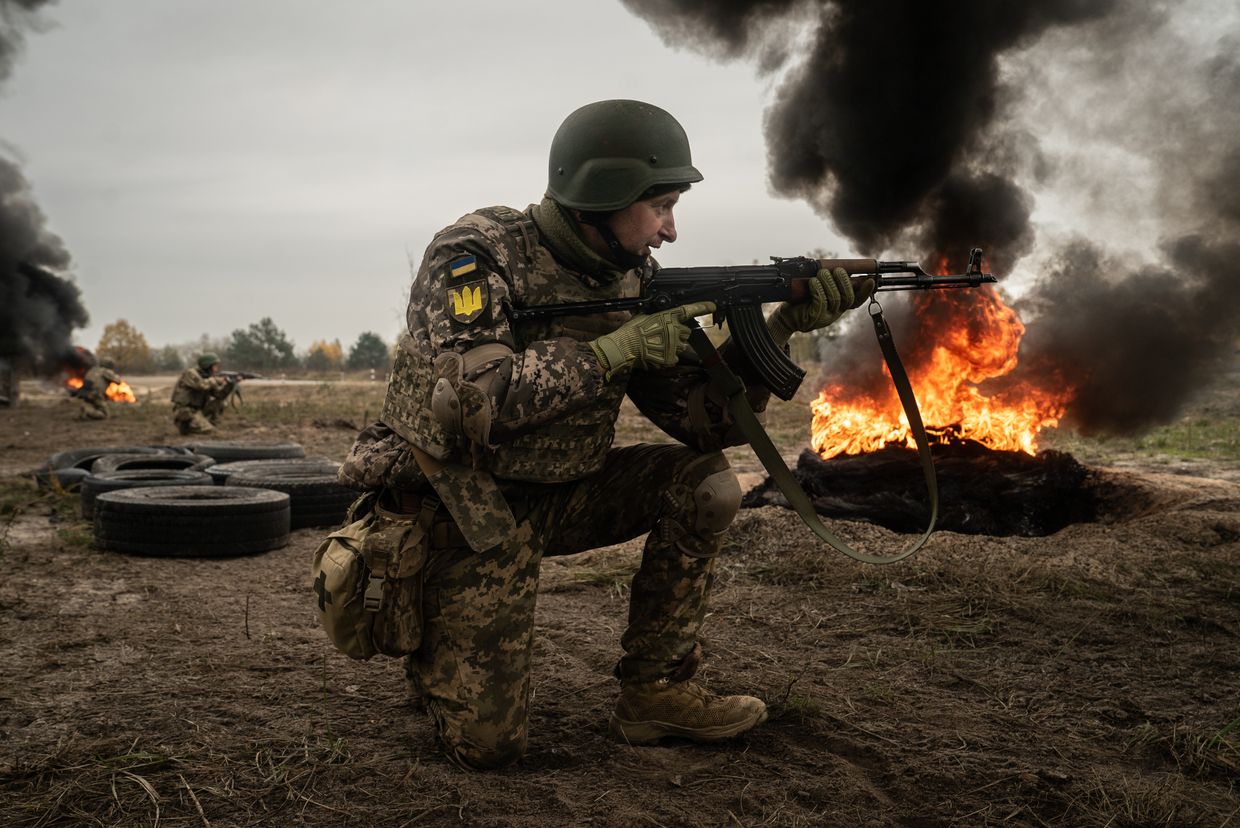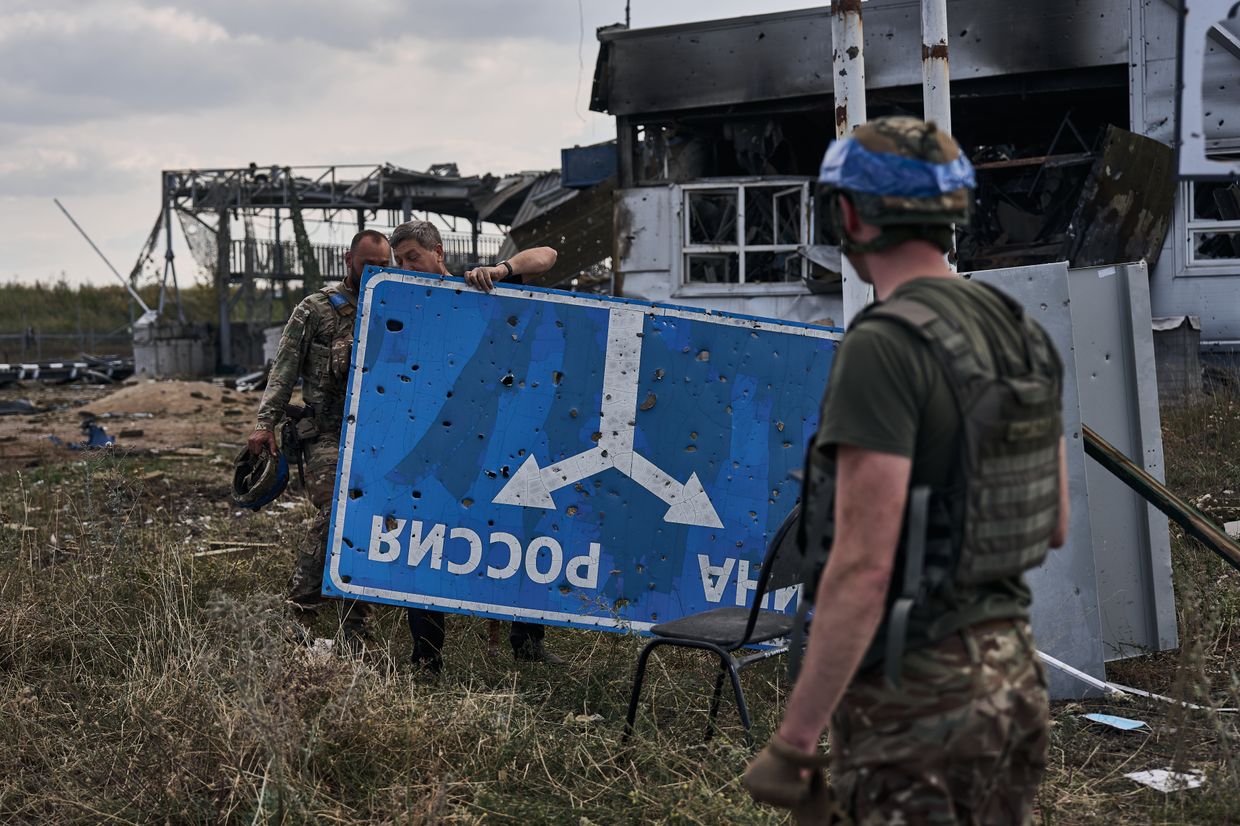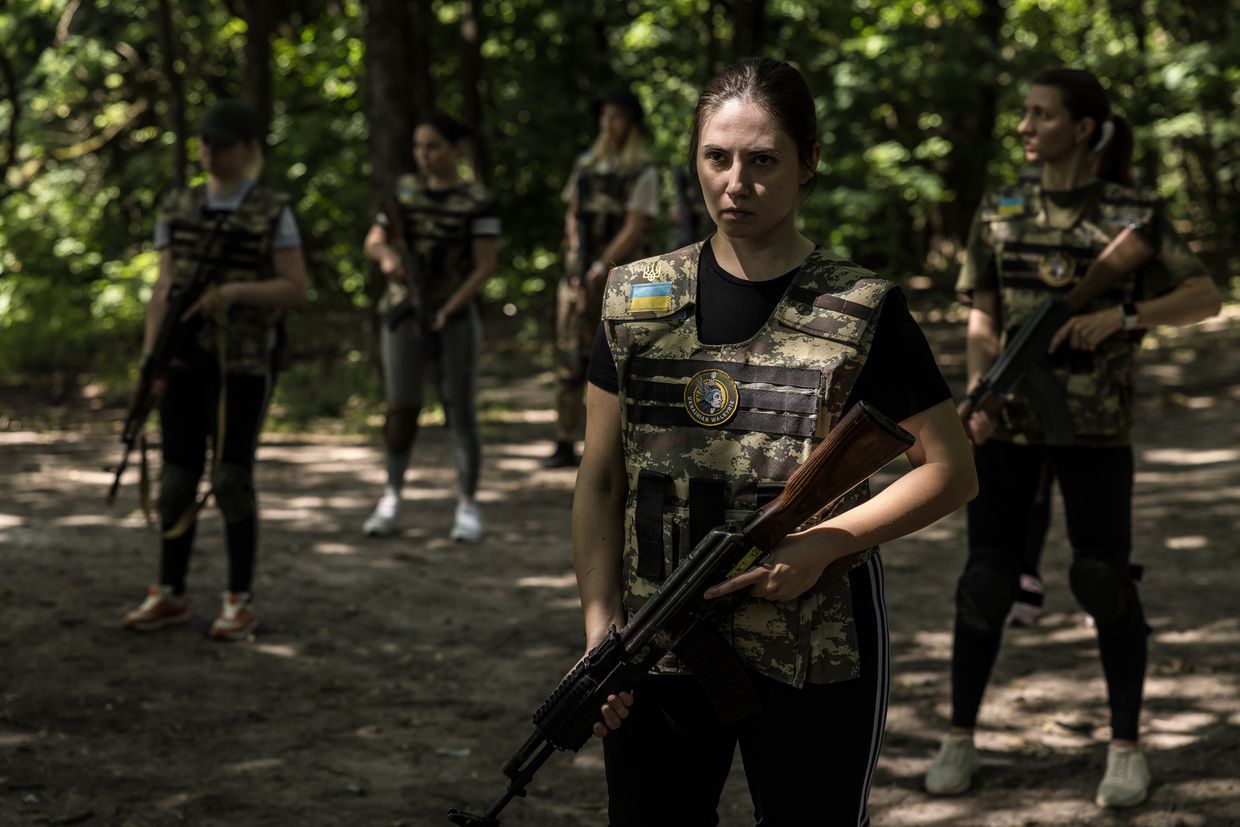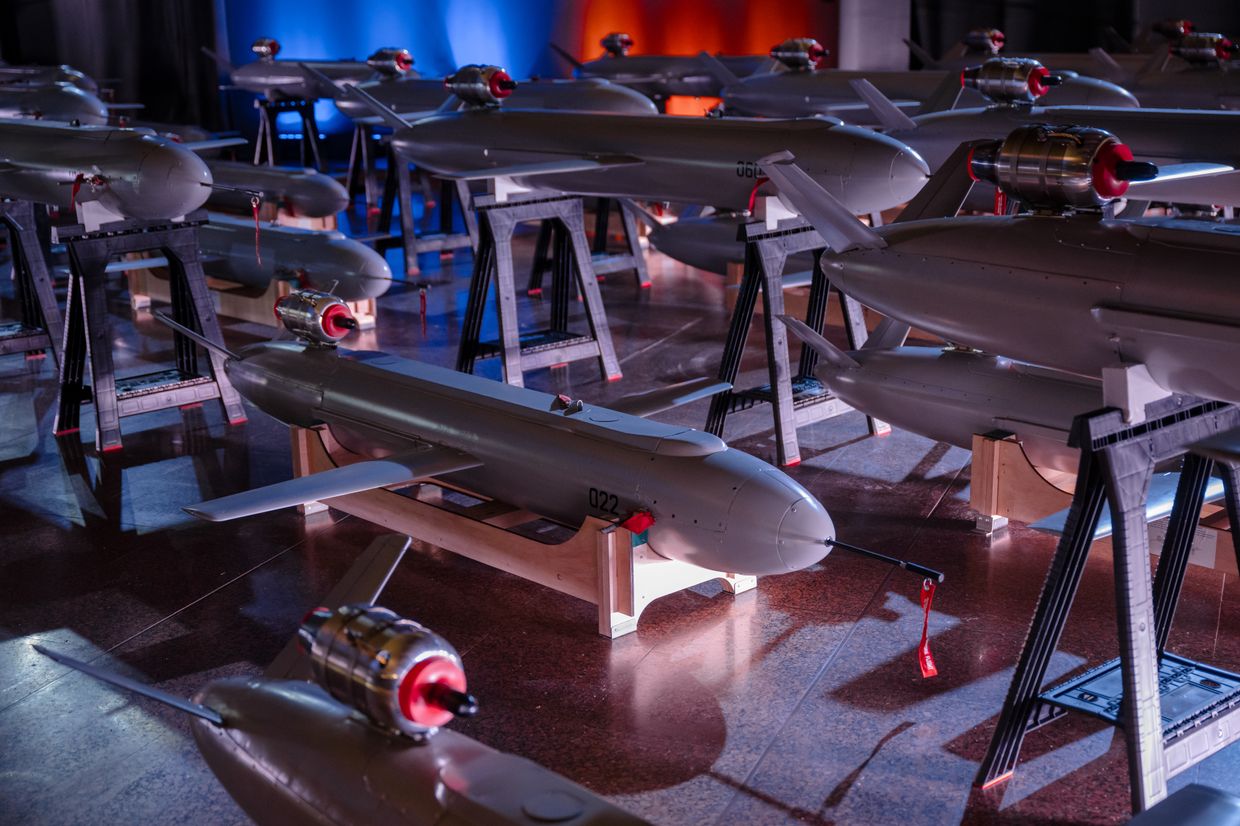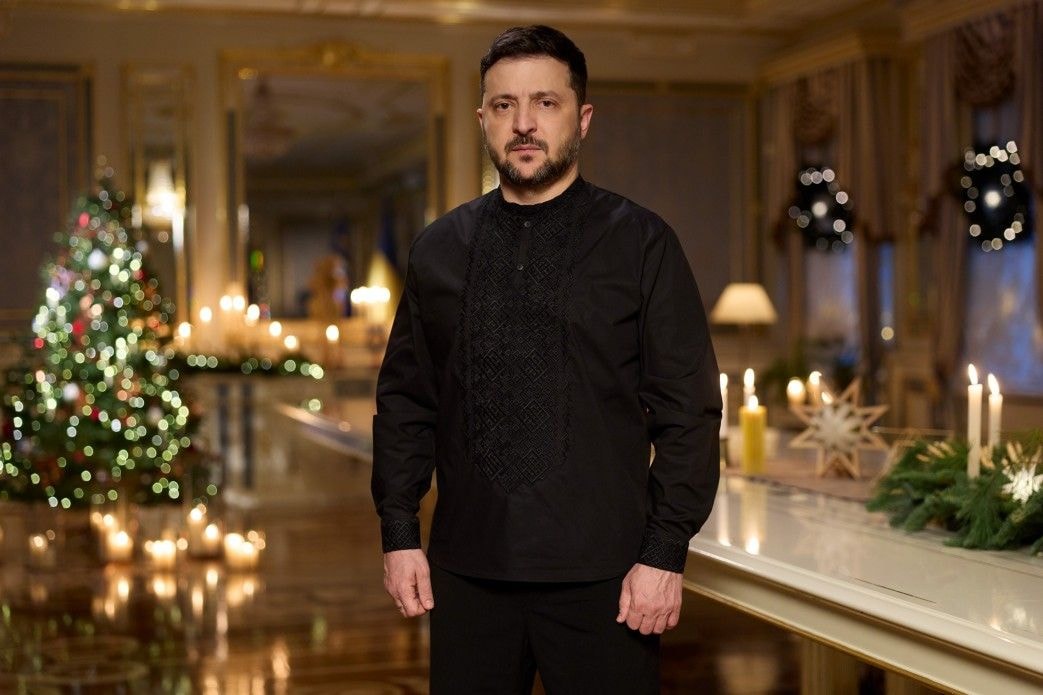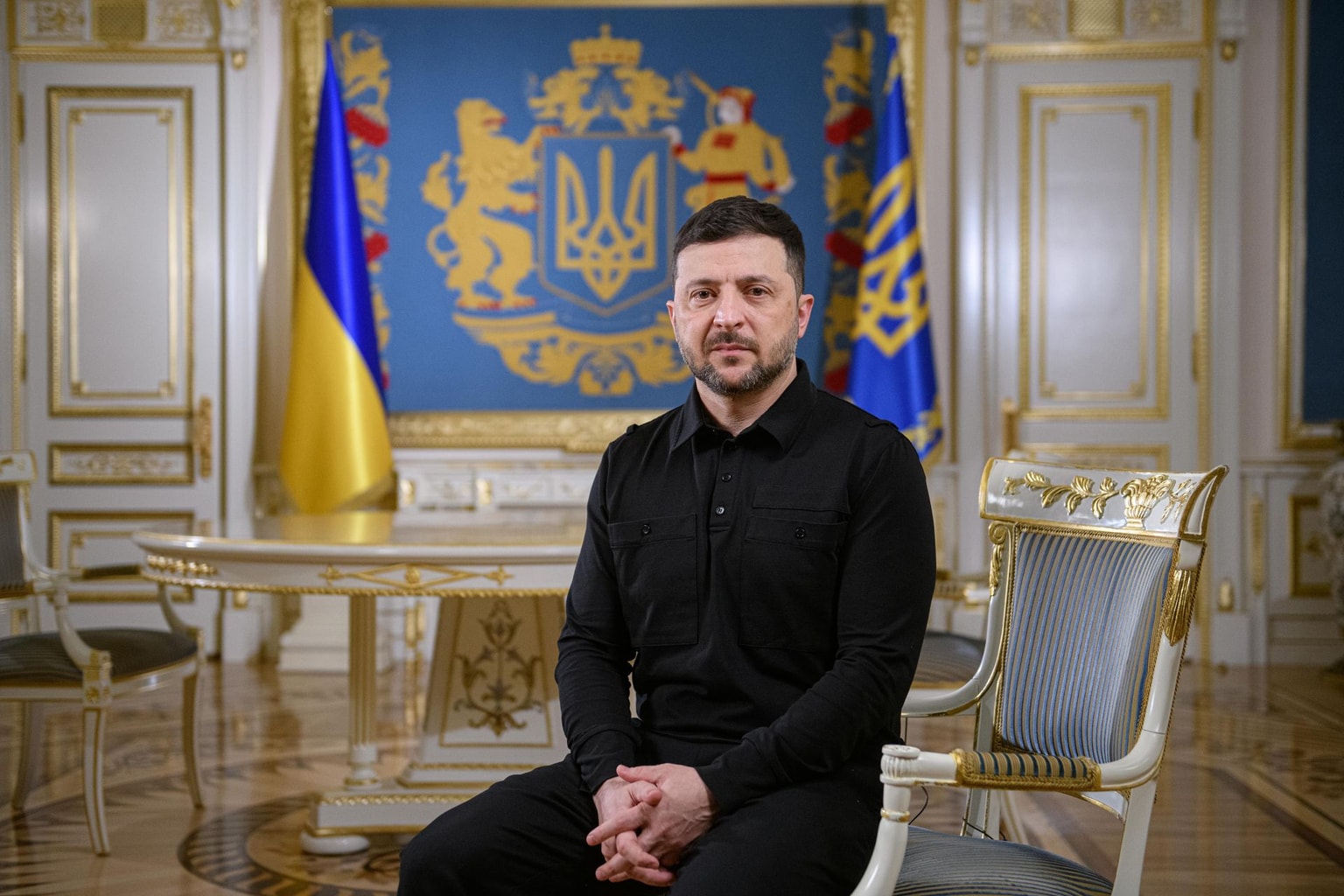
Our readers' questions about the war, answered. Vol. 8
A member of the 24th Mechanized Brigade takes part in training in eastern Ukraine, on March 18, 2025. (Roman Pilipey / AFP)
Editor's note: We asked members of the Kyiv Independent community to share the questions they have about the war. Here's what they asked and how we answered.
Join our community to ask a question in the next round.
Question: Is Ukraine formulating a plan to receive and house refugees from occupied territories? I would expect in that ceding territory many Ukrainians would want to leave Russian control.
Answer: Handling internally displaced people (IDPs) has been a pressing issue for Ukraine ever since the start of Russia's full-scale invasion. According to the Social Policy Ministry, there are currently nearly 5 million IDPs in Ukraine, 3.6 million of whom left their homes after Feb. 24, 2022.
However, state support is widely considered insufficient, with most IDPs relying primarily on charities and NGO assistance. The monthly amount of financial aid from the state is currently Hr 2,000 ($48) per adult and Hr 3,000 ($72) per child or person with a disability — not enough to maintain a decent standard of living.
The most critical issues for IDPs include the lack of proper and affordable housing, financial instability, difficulty finding employment, and deteriorating mental health. Insufficient support also forces some IDPs to eventually return to front-line or even occupied settlements.
Read this story to find out more — "Thousands of Ukrainian IDPs are struggling to adapt amid housing, employment crises." — Daria Shulzhenko, reporter
Question: Do Ukrainians still trust and respect President Zelensky? Do they still want him to be their president? Do they agree with how he is handling the war?
Answer: Yes, the majority of Ukrainians still support President Volodymyr Zelensky. Even more so after his brutal encounter with U.S. officials at the White House.
According to the latest poll published by the Kyiv International Institute of Sociology on March 27, 69% of Ukrainians trust the president.
The survey found that only 28% of respondents do not trust Zelensky, resulting in a trust-distrust balance of +41%.
Zelensky remains the most popular politician in the country and the majority of people in Ukraine support him. Yes, there are mistepps, quite a few actually, but I don't see the country turning on Zelensky.
If the presidential election were held this weekend, Zelensky would definitely advance to the runoff and likely win it. The only potential competitor is former Commander-in-Chief Valerii Zaluzhnyi, who now serves as the country's ambassador to the U.K.
Some polls have Zaluzhnyi in the lead, but the general had never officially announced his intention to run and it remains to be seen what he will do if he does. — Oleksiy Sorokin, deputy chief editor

Question: With regard to Russia's ongoing difficulties recruiting soldiers and their heavy losses on the front line, what actual difference has this made in the fighting? Also, I read about Russia's losses in your newsletter but not much about Ukraine's?
Answer: Russian losses in this war are staggering. Will this have an effect on Russia's ability to continue the war against Ukraine? No.
Ukraine has less people and resources to spare. A neverending manpower shortage is the biggest problem Ukraine is facing in this war. And there are too few options on how to fix it.
While it is believed that Russia has lost twice as many people, maybe three times as many people as Ukraine has, the Kremlin can easily afford it.
Ukraine cannot.
Russia has a population 3.5-4 times larger than that of Ukraine. Russia, unlike Ukraine, is a totalitarian dictatorship where the lives of people mean nothing to the government apparatus. So, they will continue to use all the tools at hand to call up more people to fight.
Russia also has the ability to offer substantial sign-up bonuses to those willing to fight, recruit mercenaries from Asian and African countries, and is willing to throw the disenfranchised, primarily convicts, to storm positions without carrying will those people survive the initial attack.
To follow developments in Russia I recommend our WTF is wrong with Russia? newsletter, to follow the battlefield and the Ukrainian side of things, I would recommend our War Notes newsletter. — Oleksiy Sorokin, deputy chief editor
Question: Do we know where the population of the occupied territories stands in relation to Ukraine forfeiting territories in a "peace" deal?
Answer: Recent developments are taking a toll on the people in the occupied territories. Since 2022, Ukrainians living under occupation have kept their hopes they will be liberated the same way that residents of Kyiv, Kherson, and Kharkiv oblasts were that year.
Ukrainians living there told me that one of the hardest parts now is listening to all the discussions about territorial concessions from the U.S., and how they often omit that these are real lives, real people who will have to either abandon their homes for an unknown period or live their lives under Russian occupation.
Since the possibility of liberating these territories through force is extremely slim, the atmosphere is very gloomy, and hope is hard to come by. That doesn't mean that the anti-Russian resistance fizzled out. Resistance groups, both violent and non-violent, still remain active, and for many, it is this resistance that helps them keep going. — Martin Fornusek, senior news editor
Question: Do you believe that the EU can give enough arms and security forces in a timely manner to protect Ukraine?
Answer: Yes. But for that to happen, Europe needs to step up.
Excluding some complex military hardware, such as the Patriot air defense systems and the extremely effective Bradley armored fighting vehicles, Europe knows how to build guns. It's just not building them enough.
If Europe moves from talking to acting and begins rearming at a proper pace, the EU would be able produce weapons that would keep Ukraine in the fight. Ukraine also now has the know-how of how to build proper weaponry. It just needs the funds to increase production capacities.
The ReArm Europe initiative is a good start. The industry is also there. Now we need to see orders. — Oleksiy Sorokin, deputy chief editor
Question: French President Macron's position on the war in Ukraine has undergone quite a few changes since the start of the full-scale invasion, and I think it's fair to say that he is now fully and clearly committed to Ukraine. How is he currently perceived by Ukrainian public opinion, and are there any high expectations of him?
Answer: The public opinion regarding President Macron went through a deep transformation from the early period of his phone calls with Putin to him proposing for European boots on the ground later in the war. In fact, according to one opinion survey last year, Macron was the only foreign leader whose popularity improved in Ukraine. In 2025, European leaders are also perceived much more positively in contrast with the U.S. under the new administration.
At the same time, many reserve judgment. Macron's pro-Ukraine turn has been mostly about rhetoric, and France still provides much less than it could in comparison to the U.K., Germany, or even smaller countries like Estonia or Denmark, which provide the largest shares compared to GDP. We'll have to see if Macron's and Starmer's "coalition of the willing" can bring something real to the table. — Martin Fornusek, senior news editor

Question: Trump is killing NATO or is at least withdrawing our country from it. Will Europe replace it with an EU army? Is it time for the EU to form a constitutional union better than what I feel we are losing with Trump and his MAGA party.
Answer: Unfortunately, further integration of the EU in the current political climate is difficult, and a united EU army is a far-off dream.
It is undeniable that the EU has reacted well to Trump's foreign policy turn, namely in terms of higher defense spending and clearly demonstrating firm support of Ukraine.
But, the EU is still composed of countries with often contradicting interests, and consensus is hard to come by. It's not only "rogue members" like Hungary and Slovakia — Italy, France, and Germany have different foreign and economic priorities that hamper united decision-making. For example, despite worries about Trump abandoning Ukraine, the EU was not able to agree on a new 40 billion euro package due to opposition from southern members.
Political trends suggest this might only get more difficult, as far-right and Euroskeptic parties are on the rise in both France and Germany.
In terms of military capabilities, Europe is still playing catch-up. Their militaries have been underfunded for decades and are often reliant on NATO infrastructure, which will be very hard to replace. We hear calls for a European alternative to the alliance, but that will demand years — if not decades — of sustained work. — Martin Fornusek, senior news editor
Question: How does drafting and mobilization work? Do the Ukrainian Armed Forces view draft evasion as a big problem? Is there an issue of corruption or morale among the population?
Answer: The large-scale, forced mobilization of men into the military was, is, and always will be not only incredibly painful and tragic but also the greatest internal political and social challenge in a country that otherwise remains united in its resolve to not capitulate to Russia's attempt to destroy Ukraine as a nation. No country should have to go through this.
It's important to make one thing clear: Ukraine's manpower crisis refers specifically to the infantry; this is the deadliest, most difficult, and most uncomfortable job in the military. This is where the most casualties are taken, and this is where the most new recruits are needed to fill the ranks. In a war that is now dominated by drones, where anyone or anything moving around on the surface can be hunted by several high-precision drones within a few minutes, the life of the infantryman is truly horrible, and often, no amount of patriotism is enough for the average Ukrainian to take up this job. Lots of people are still joining the military voluntarily, but they are almost all going to other roles, especially in drone units. In fact, some are joining drone units voluntarily, specifically to avoid eventually being drafted into the infantry, while others, as you mentioned, choose to hide at home.
Unfortunately, this situation isn't really getting better, as more people are still needed to avoid losing the country. If you ask me, the main hope to solve the manpower crisis is for two things to happen: First, the Ukrainian leadership needs to prioritize reforming mobilization, training, and especially how its soldiers are used on the battlefield so that the life of the Ukrainian infantryman is placed at front and center of the planning of operations on all levels. Second — and longer term — the military should learn to play to their strengths of drone warfare and do more and more to change how we understand the way war is being fought, with a wider gray area between positions that can be a great big killzone for Russian troops without Ukrainian infantry to have to be there. — Francis Farrell, reporter

Question: I have a question related to the new proposal for a one-year military contract for citizens between 18-24. What is the status of this proposal? Is it implemented already or is it currently being discussed in the Rada? Which processes are necessary for it to be adopted, and do we know if this is likely to happen or is it facing many obstacles?
Answer: The Defense Ministry officially launched the "Contract 18-24" project on Feb. 11, and volunteers can already apply online. Deputy head of the Presidential Office Pavlo Palisa described it as a "pilot project" in its "test mode," however. The project is being carried out on a limited scale so far, including four Ground Forces brigades, one Airborne brigade, and one Marine brigade.
Based on the results, there are plans to further expand the project to other units. The number of people who signed up via this procedure is in the hundreds, not thousands. — Martin Fornusek, senior news editor
Question: We, your readers, hear constantly about the need for re-organization and reform of the Ukrainian military. For me, and other non-Ukrainians with a serious interest in Ukraine, can you discuss the current problems, like what happened to Zaluzhnyi, what's up with Commander-in-Chief Oleksandr Syrskyi, and the aspects of corruption and mismanagement in the Ukrainian military?
Answer: Here, I am very happy to direct you to our latest article on this exact topic, by my colleague Natalia Yermak and myself. What's up is that while Ukraine is waging a brutal struggle against Russian forces in the trenches and fields, it is also waging another battle, an internal one, against a military culture steeped in Soviet-era practices and mentalities that lead to excess loss of life and territories — the two things most dear to Ukraine in this war. There is a lot to go into, from the exact way that this actually manifests itself on the battlefield, to the persona of Oleksandr Syrskyi himself and the efforts to change the system, and for that, you should definitely check out the article. — Francis Farrell, reporter
Question: In relation to the ongoing discussions about the Russian invasion, why is the Russian side not interested in peace?
Answer: Russia launched its full-scale invasion of Ukraine in 2022 with an attack on the capital, Kyiv, as part of a broader attempt to decapitate and destroy the independent Ukrainian state. That attempt failed then, but now, having made progress in their war of attrition, and with the U.S. now abandoning the policy of supporting Ukraine's struggle and instead looking more and more likely to abandon Kyiv altogether, the Russians are feeling pretty good about their position.
Even their stated minimalist goals call for the handover of a lot more Ukrainian territory in Donetsk, Kherson, and Zaporizhzhia oblasts, inhabited by millions of Ukrainians. This is what the world, including U.S. President Donald Trump, needs to understand: Russia is absolutely not interested in peace simply because they started this war wanting a lot more, and they feel more confident in their ability to get it than they have in three years. — Francis Farrell, reporter
Question: What is the reason behind the Trump administration's Russian propaganda talking points?
Answer: Without actually getting inside their heads — which I don't think I'd enjoy in the slightest — it's impossible to say for sure. But, I guess there's a sort of sliding scale of possible reasons, none of them particularly encouraging.
At one end of the scale, there is the possibility that they're just underqualified, naive, inexperienced, and are falling for Russian propaganda.
I'd say Steve Witkoff is perhaps the best example of this — he's a real estate mogul, with no experience of politics or diplomacy, and was positively swooning about Putin after meeting him in Moscow last month. And all it seemed to take was a bit of a smile from Putin and a painted portrait of Donald Trump as a gift to take back to the White House.
Put yourself in his shoes: going from the world of luxury real estate to suddenly finding yourself in the Kremlin — discussing the future of entire countries — must be pretty intoxicating.
And what's the result? You fall for the spectacle and take Putin at his word. Next thing you know, you're chatting to Tucker Carlson, telling him that any Ukrainians who speak Russian are absolutely fine with living under Russian occupation.
In the middle of the scale, there is the possibility that they just don't actually care about what they're saying, so long as they get what they want.


Trump is the perfect example of this — he wants the mineral deal signed, and he was willing to say whatever it took to pressure Zelensky to do it. And, if you want to say something bad about Zelensky, and you're looking for material, then all of those pre-prepared Kremlin lines that propagate so fruitfully on social media are just sitting there waiting for you.
I think this is the most likely reason, which is pretty terrifying. I recently interviewed historian Marci Shore about why she and her husband, Timothy Snyder, are leaving the U.S. to teach in Canada, and she put it perfectly.
Speaking about the Oval Office showdown, she said, "This was the profound moment that exposed that you're dealing with people for whom there are no first principles, you're just looking into this abyss of moral nihilism. Everything is a transaction, everything is a deal."
At the other extreme end of the scale, we get into the slightly conspiratorial world of "Is Donald Trump a Russian asset?"
We covered this in another interview with an author who is absolutely convinced he is. He has written two books about it, and there's a lot of compelling evidence, but no smoking gun.
Regardless, it's enough of a concern that even a British MP has raised it as a possibility.
But it's sort of a moot point at the end of the day — whether Trump is a Russian asset or not, he's sure acting like one. — Chris York, news editor
Question: What is the situation with the Ukrainian troops in Russia's Kursk Oblast? We hear stories that they are surrounded. Other stories say they are retreating back to Ukraine. Have they got home safely?
Answer: Ukraine has had to withdraw from most of Russia's Kursk Oblast, a long-expected outcome after the troops on the ground have suffered from critical logistical issues for months.
Ukraine is still holding onto a small patch of territory in Kursk Oblast near the border, which Western military experts have said was likely to prevent a Russian breakthrough into Ukraine's adjacent Sumy Oblast in the northeast. The withdrawal appears to have been chaotic as always, which — like in the cases of Avdiivka, Bakhmut, and Kurakhove — could have been avoided by withdrawing weeks or a month earlier.
But the withdrawal wasn't as bad as it could have been, with no major encirclements, according to both troops on the ground and experts. Soldiers have had to walk on foot though for days, leaving their valuable equipment behind. Many raised concerns over expending manpower and limited resources into invading another country's territory when they could have been used to defend one's own, especially as Russia gained ground on the eastern front — where many of the units participating in the cross-border operation were previously deployed — over the second half of 2024. — Asami Terajima, reporter
Question: Ukraine is obviously maintaining the position that the parts of the four oblasts Donetsk, Luhansk, Zhaporizhia, and Kherson that are not in Russian hands can never be ceded to Russia in a ceasefire, nor will the effectively occupied parts legally be recognized as Russia. But how far can Ukraine be forced by the U.S. to make concessions in this respect?
Answer: Zelensky has to walk a fine line on this issue, balancing the need to retain U.S. support — which right now Ukraine definitely does need as Europe isn't ready to fill the gap just yet — and public opinion.
The latest opinion poll found that 38% percent of Ukrainians were open to conceding territory in a peace deal, up from 8% in December 2022.
But the number of Ukrainians who oppose giving up territories under any circumstances, "even if this would prolong the war and threaten the preservation of independence," stands at 51%.

Obviously, these numbers could shift further in the future, but right now, Zelensky is in a tricky spot.
But it's just too early to know what sort of concessions the U.S. will demand of Ukraine, and given the absolute craziness of the last couple of months, it's impossible to predict.
One point worth stressing, however, is that those polls do not include the views of the millions of Ukrainians currently living under Russian occupation. The debate among politicians and the media tends to focus on land, but it's also lives that are at stake.
Unfortunately, Trump doesn't seem to take matters like this into account in his pursuit of just getting deals done, so what is abhorrent to you and I, is nothing of the sort in his mind. — Chris York, news editor
Question: Why doesn't Ukraine conscript women into the military forces like men?
Answer: I don't know the official reasoning for why Ukraine doesn't conscript women, but I think it goes back to the traditional war mentality that women could take over the jobs needed to keep the cities running. Despite the critical manpower shortage, many Ukrainian soldiers — predominantly over the age of 45 — that I have met said the last thing they want is for women to be forced into the war, saying that they are fighting at the cost of their lives to protect women and children.
But Ukrainian women have also proven to be excellent soldiers, sometimes successfully taking over leadership roles and conducting extremely dangerous missions. — Asami Terajima, reporter
Question: There are a fair number of NATO nations individually providing military equipment. But seeing as they are of different origin, operational characteristics, maintenance needs, and "operating manuals," has this proven a problem for Ukrainian troops on the front lines?
Answer: Yes, this has been a major issue for Ukrainian soldiers, requiring a fair bit of tinkering with the weapons received. This has particularly complicated the match-up between arms and ammunition, with Ukrainian soldiers reporting the need to re-distribute gunpowder between disparate shells and explosives regularly. — Kollen Post, defense reporter
Question: After the recent interruption of weapons deliveries and intelligence, is everything back to normal? Is my country now meeting its commitments under the Trump administration (as the majority of the American people want)?
Answer: As far as we know, yes, but that comes with a few caveats.
The nature of intelligence sharing means few, if any, details about the state of the current relationship between the U.S. and Ukraine are public, or will be made public, so all we have to go on are the statements made by officials. And, according to both sides, it's back up and running. Whether or not it's up and running at the same level it was, we don't know.
As an aside, there was a great piece in the NYT on the intelligence relationship between the U.S. and Ukraine throughout the full-scale invasion, though notably, it doesn't cover any of the period since Trump took charge. It's very much worth a read, though.
As for military aid, that which was allocated by President Joe Biden is still making its way to Ukraine after the pause.
The crucial question here is how long will it last? Trump has yet to authorize any new weapons shipments and has tied future aid to the minerals deal which is still yet to be signed. So it's all a bit murky as to how it will play out.
One notable recent announcement was that on April 3, U.S. General Christopher Cavoli said more F-16 fighter jets are being prepared for transfer to Ukraine. — Chris York, news editor
Question: What can individuals around the world do to help Ukraine the most?
Answer: This is one of the most frequently asked questions from our readers and members. The most obvious answer is to donate — two well-known organizations that support those on the front line are Come Back Alive and the Hospitallers. Especially since the suspension of USAID funding, donating even a few dollars can make a big difference: Ukraine was the largest recipient of U.S. economic aid, receiving over $14 billion in 2023.
Outside of making a monetary contribution, you can also contact your elected representatives, asking them to vote in favor of initiatives that help Ukraine, boycott companies that still operate within Russia, and read and share news from Ukraine. We've even made this list about how to help Ukraine, so it's easy for you to share. And most importantly, don't give up — every effort counts. — Brooke Manning, senior community manager


